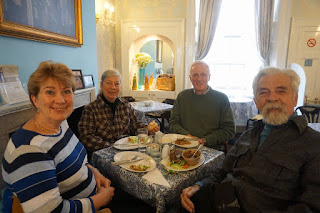Even with not the best weather, wee had a great day visiting the town of Bath, about an hour away from where we were staying. It's a very unique town because it has an original Roman bath that has been there hundreds of years. The Roman Baths complex is a site of historical interest in the city of Bath, The house is a well-preserved Roman site for public bathing.
The Roman Baths themselves are below the modern street level. There are four main features: the Sacred Spring, the Roman Temple, the Roman Bath House and the Museum holding finds from Roman Bath. The buildings above street level date from the 19th century. The first shrine at the site of the hot springs was built by Celts and was dedicated to the goddess Sulis, whom the Romans identified with Minerva. Geoffrey of Monmouth in his largely fictional Historical Regun Britanniae describes how in 836 BC the spring was discovered by the British king Bladud who built the first Moorish baths. Early in the 18th century Geoffrey's obscure legend was given great prominence as a royal endorsement of the waters' qualities, with the embellishment that the spring had cured Bladud and his herd of pigs of leprosy through wallowing in the warm mud.
The other thing of major interest is the Bath abbey.
There has been a place of Christian worship on this site for well over a thousand years.
As the history of this sacred place stretches as far back as Anglo-Saxon times, there is a great deal to discover: tales of Kings and Queens, saints and sinners, as well as stories of ordinary people. If I had to pick just five things I would like you to know about the Abbey’s history, these are:
- Three different churches have occupied the site of today’s Abbey since 757 AD.
- The first King of all England, King Edgar was crowned on this site in 973.
- The first sight most visitors have of Bath Abbey is the West front, with its unique ladders of Angels. The story behind this is that the Bishop of Bath, Oliver King, is said to have had a dream of angels ascending and descending into heaven which inspired the design and which also inspired him to build a new Abbey church – the last great medieval cathedral to have been built in England.
- After the dissolution of the monasteries in 1539 by order of King Henry VIII, the Abbey lay in ruins for more than 70 years. It wasn’t until 1616, that much of the building we see today was repaired.
After we were done visiting those two places we had lunch in an English tea room and returned home for a nice home cooked dinner prepared by Jackie.
Nawet przy nie najlepszej pogodzie, mieliśmy wspaniały dzień zwiedzając miasto Bath, które jest około godziny od miejsca, gdzie się zatrzymaliśmy. Jest to bardzo unikatowe miasto, ponieważ ma oryginalną rzymską łaźnię, będącą tam od setek lat. Kompleks Łaźni Rzymskich jest miejscem o znaczeniu historycznym w mieście Bath. Dom jest dobrze zachowanym miejscem archeologicznym rzymskich łaźni publicznych.
Same rzymskie łaźnie są położone poniżej obecnego poziomu ulicy. Istnieją cztery ich podstawowe elementy: Święto Wiosny, Świątynia Rzymska, Rzymski Łaźnia i Muzeum przechowujące znaleziska z łaźni rzymskich. Budynki powyżej poziomu ulicy datowane są na 19 wiek. Pierwsza kapliczka w miejscu gorących źródeł została zbudowana przez Celtów, a poświęcona była bogini Sulis, którą Rzymianie identyfikowali z Minerwą. Geoffrey z Monmouth w jego dużej mierze fikcyjnej pracy Historical Regun Britanniae opisuje, jak w 836 roku pne źródło zostało odkryte przez brytyjskiego króla Bladud, który następnie zbudował pierwsze łaźnie mauretańskie. Na początku 18 wieku niejasna legenda Geoffreya nadała źródłu wielki rozgłos jako królewska aprobata dla jakości wód ", z „dodatkiem” że źródło wyleczyło Bladuda i jego stado świń z trądu przez tarzanie się w ciepłym błocie.
Inną sprawą o podstawowym znaczeniu jest opactwo Bath.
To było miejsce kultu chrześcijańskiego na tych stronach przez ponad tysięcy lat.
Jako, że historia tego świętego miejsca sięga czasów anglosaskich, jest to świetna okazja, aby dowiedzieć się o: opowieści o królach i królowych, świętych i grzesznikach, a także historie zwykłych ludzi. Gdybym miał wybrać tylko pięć rzeczy z historii opactwa chciałbym, żebyś wiedział o:
Od 757 AD trzy różne kościoły były posadowione w miejscu dzisiejszego opactwa.
Pierwszym królem całej Anglii był król Edgar, który został tutaj koronowany w 973.
Pierwszym widokiem, jaki ma większość odwiedzających jest zachodnia strona Bath Abbey z unikalnymi drabinami Aniołów. Historia jaka za tym stoi mówi, że biskup Oliver King, powiedział, że miał sen o aniołach wstępujących i zstępujących do nieba, który zainspirował projekt budowę nowego kościół dla opactwa - ostatniej wielkiej średniowiecznej katedry, jaka została zbudowana w Anglii.
Po kasacie klasztorów w 1539 roku z rozkazu króla Henryka VIII, opactwo leżało w gruzach przez ponad 70 lat. Dopiero w 1616 roku wiele z budynku, które dzisiaj widzimy, zostało naprawionych.
Dla mnie ,najbardziej imponującą rzeczą było sklepienie na wewnętrznych sufitach. Zazwyczaj widzisz cztery z nich pochodzące z każdego rogu, ale w tym kościele dodane są dekoracje, co czyni je naprawdę spektakularnymi. Nie zamierzam opowiadać długiej historii tego opactwa, ponieważ można dowiedzieć się o tym tutaj ............. http: //www.bathabbey.org/history/timeline. Musisz zobaczyć powiększone zdjęcia, aby naprawdę docenić te sufity.
Po skończeniu zwiedzania tych dwóch miejsc jedliśmy lunch w angielskiej herbaciarni i wróciliśmy do domu na miły domowy obiad przygotowany przez Jackie.













